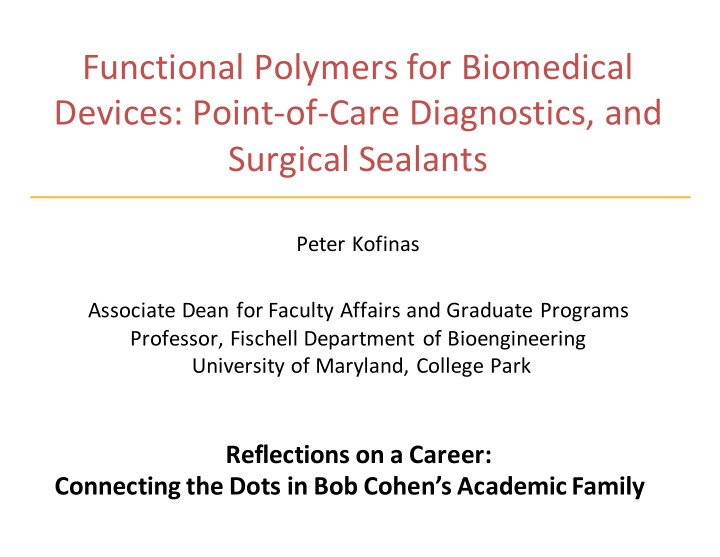



Functional Polymers for Biomedical Devices: Point-of-Care Diagnostics, and Surgical Sealants Peter Kofinas Associate Dean for Faculty Affairs and Graduate Programs Professor, Fischell Department of Bioengineering University of Maryland, College Park Reflections on a Career: Connecting the Dots in Bob Cohen’s Academic Family
Maryland Basketball Game 11/2009
Thank you Bob!
Enzyme Induced Stiffening of Nanoparticle-Hydrogel Composites with Structural Color Enzyme Initial Red Hydrogel Collapsed Blue Hydrogel Enzymatic cleavage of the peptide-polymer bonds alters the spacing between particles, changing the color of the hydrogel Ayyub et al. ACS Nano 2015
Fabrication of Nanocomposite 4-Arm PEG Norbornene CYKC Peptide Silica Nanoparticles (PEG4NB) ℎ𝑤 1:4 PEG4NB to CYKC Polymerized Colloidal Array Ayyub et al. ACS Nano 2015
Threshold Response Yields Logic Gates 70% of cross-links must be cleaved for response • Incorporate two peptides specific to two different proteases • at 1:1 ratio as cross-links Degradation of both is needed for 70% threshold • Ayyub et al. ACS Nano 2015
Breaking of Chemical Bonds Yields Color Change Failure to Blueshift 70 • Nonspecific peptide was Time to Blueshift (minutes) 60 introduced into the hydrogel 50 Breaking 70% of • 40 crosslinks induces blueshift 30 Increased • 20 concentration of non- cleavable peptide 10 100 90 80 70 60 50 increases time to Percent CYKC blueshift Ayyub et al. ACS Nano 2015
Concentration Dependent Response Time Theoretical Time to Blueshift ' ( ) * 𝑢 $ = +,- (./ 0 Fraction of cross-links cleaved X c to initiate collapse Peptide cross-link S o concentration Turnover rate k cat Protease Concentration E
Metabolic Disorder Management • Hyperammonemia: complication of urea-cycle disorder • Occur in 1 out of 10,000 births • Current analysis takes days – Hard to diagnose • Without treatment, patients suffer irreversible brain damage, or even death
Ammonia Sensor Design Ayyub et al. Molecular Genetics and Metabolism, 2015
Berthelot Specificity Toward Ammonia Ammonia Ammonia Gly Arg Gly Arg Gln Ala Gln Ala Glu His Glu His Asp Asn Asp Asn Tyr Ile Tyr Ile 100 100 75 75 8 50 50 25 25 6 4 2 Trp Cys Trp Cys Val Leu Val Leu Thr Met Thr Met Lys Phe Lys Phe Pro Ser Pro Ser Larger response of ammonia versus amino acids present in blood Ayyub et al. Molecular Genetics and Metabolism, 2015
Ammonia Microfluidic Device 25 µ M 100 µ M 250 µ M 500 µ M
Blood Ammonia Standard Curve Linear detection of blood ammonia with microfluidic device using 40 μl blood Ayyub et al. Molecular Genetics and Metabolism, 2015
Direct Deposition of Body Temperature Responsive Polymeric Medical Sealants Conventional suturing and tissue stapling § Intestinal, vasculature, or airway anastomosis § Liver, lung, or kidney resections Current commercial sealants have drawbacks including cost, shelf stability, complex preparation, or difficult application www.georgelianmd.com http://www.atlasofpelvicsurgery.com/
Solution Blow Spinning Behrens et al. ACS Macro Lett. (3) 249-254 (2014)
Differential Scanning Calorimetry Behrens et al. Advanced Materials, 2015
Fiber Mat Heating 10% PLGA 5% PEG fiber mat at 31 o C • 31 o C Film Fiber Mat
Adhesion Testing 15 14 10% PLGA 0% PEG 13 10% PLGA 1% PEG 12 10% PLGA 3% PEG 11 10% PLGA 5% PEG 10 9 Blow Spun 8 N/cm2 Polymer 7 6 5 1” X 1” 4 Face 3 2 1 0 RT 37C Large increase in adhesion at 37C Behrens et al. Advanced Materials, 2015
Cecal Intestinal Anastomosis Mouse Model 4-Suture Anastomosis PLGA/PEG Deposition PLGA/PEG After 2 Minutes 24-Hour Burst Pressure
1-Day Burst Pressure ˚ 80 4-Suture Control 60 Burst Pressure (mmHg) 40 ˚ 20 PLGA/PEG 0 PLGA/PEG Tisseel Coseal Control >2X Greater Burst Pressure (n = 5) • 7-day survival: 40% Improvement over control • Behrens et al. Advanced Materials, 2015
2007 World Series
Recommend
More recommend